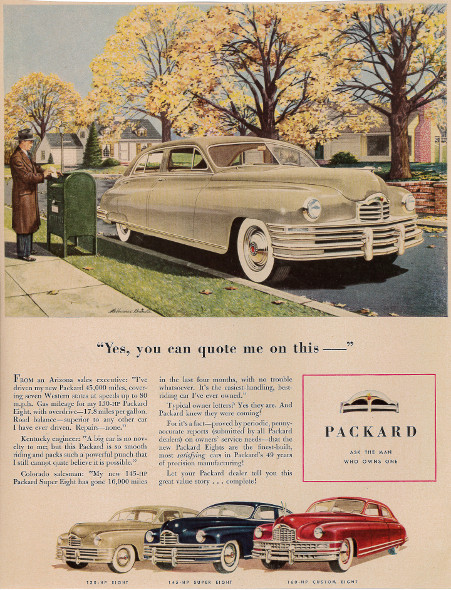By Robert Tate, Automotive Historian and Researcher
Images courtesy of the National Automotive Collection
Posted: 12.12.2016

“You just know it’s a Packard.” That was one of the great automotive advertising themes that was used for Packard in 1949. The 1949 Packard models were great looking cars that found a good deal of success in the consumer public.
The advertising company contracted to create some of the material for Packard was handled by the Young & Rubicam, Inc. located in New York, New York on Madison Avenue. One of the more talented automotive artists who worked on the Packard campaigns was Mr. Melbourne Brindle.
Mr. Brindle, was born in Melbourne, Australia, later he would migrate with his family to San Francisco, Ca. in 1918 where he began to study great works of art which would later become admired by many Americans.

Mr. Brindle started out designing a number of stamps and cards for the United States Postal Service. I also discovered through research that Brindle designed WWII bond posters as well as designing outstanding magazine covers for the Saturday Evening Post along with many others.
As his career would continue, he would later become an illustrator for Packard automobiles. During the 1940s, Packard manufactured and had offered many great looking automobiles for the motoring public. When it came to automotive styling, the 1949 Packard models retained the previous year’s body design and the rear fenders on the models were integral with the body design. For many years, Packard designers had been world famous for their distinctive styling and their precision workmanship.

On April 28, 1949, Packard announced a completely new line of Golden Anniversary automobiles which included the “Ultramatic Drive,” which marked the only automatic transmission developed by an independent company without support from a transmission manufacturer. The Ultramatic Drive was available initially as standard equipment on the 160-horsepower Custom Eight models.
The 1949 Packard models were announced to the public on Nov.1, 1948. Although sales for that year were respectable at 116,955 units in both series and 104,593 for the calendar year, some disturbing trends were visible. Aside from lessening demand for the Custom series, the station wagon sedan was not selling well and in 1950, the company discontinued the model for good.

The new line of Golden Anniversary Packard models had contained 77 major improvements and scores of hidden changes, including improved visibility by means of a larger rear window on four-door models. The models also featured greater engine power introduced in the Eight and Super models, new interiors, better braking and greater stability.

In conclusion, the Packard automobiles and their creative advertising have a great heritage and history. And even by today’s standards, the Packard autos dominated the luxury car market for a time post-WWII. Many Packard cars are highly sought after in the antique car market of today.

A special thanks to Robert Tate, Automotive Historian and Researcher, for contributing this story to the MotorCities Story of the Week Program.
For further information on photos please visit http://www.detroitpubliclibrary.org/ or email This email address is being protected from spambots. You need JavaScript enabled to view it.. Please do not republish the story and/or photographs without permission of MotorCities National Heritage Area. (Bibliography: 1949 Packard Chrysler Corporation Engineering Division Department of Technical Data and
Information; Kimes Rae, Beverly; Grayson, Stan: “Packard A History of the Motor Car and the Company.” 1978.)
If you would like to contribute an article for the MotorCities newsletter, email This email address is being protected from spambots. You need JavaScript enabled to view it. or call 313-259-3425.



